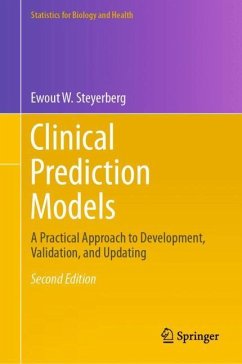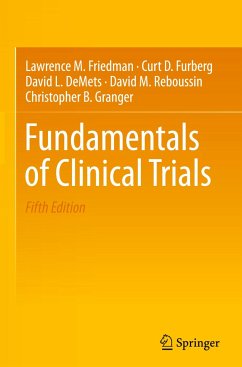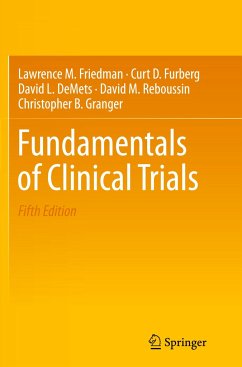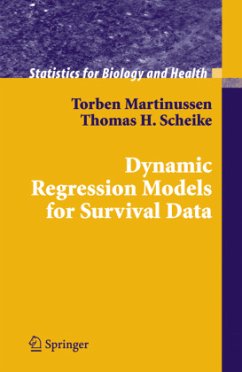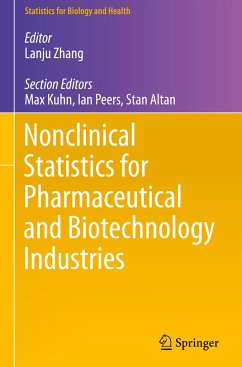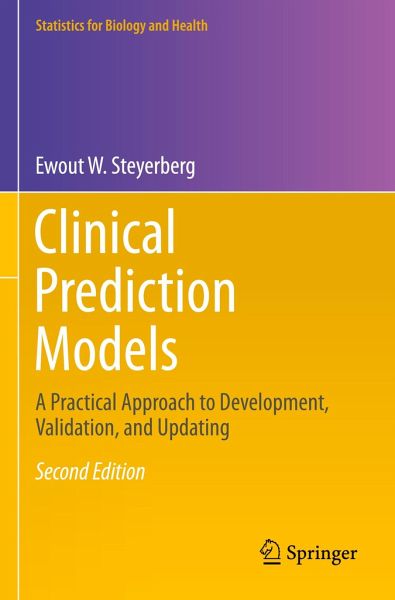
Clinical Prediction Models
A Practical Approach to Development, Validation, and Updating
Versandkostenfrei!
Versandfertig in 6-10 Tagen
49,99 €
inkl. MwSt.
Weitere Ausgaben:

PAYBACK Punkte
25 °P sammeln!
The second edition of this volume provides insight and practical illustrations on how modern statistical concepts and regression methods can be applied in medical prediction problems, including diagnostic and prognostic outcomes. Many advances have been made in statistical approaches towards outcome prediction, but a sensible strategy is needed for model development, validation, and updating, such that prediction models can better support medical practice.There is an increasing need for personalized evidence-based medicine that uses an individualized approach to medical decision-making. In thi...
The second edition of this volume provides insight and practical illustrations on how modern statistical concepts and regression methods can be applied in medical prediction problems, including diagnostic and prognostic outcomes. Many advances have been made in statistical approaches towards outcome prediction, but a sensible strategy is needed for model development, validation, and updating, such that prediction models can better support medical practice.
There is an increasing need for personalized evidence-based medicine that uses an individualized approach to medical decision-making. In this Big Data era, there is expanded access to large volumes of routinely collected data and an increased number of applications for prediction models, such as targeted early detection of disease and individualized approaches to diagnostic testing and treatment. Clinical Prediction Models presents a practical checklist that needs to be considered for development of avalid prediction model. Steps include preliminary considerations such as dealing with missing values; coding of predictors; selection of main effects and interactions for a multivariable model; estimation of model parameters with shrinkage methods and incorporation of external data; evaluation of performance and usefulness; internal validation; and presentation formatting. The text also addresses common issues that make prediction models suboptimal, such as small sample sizes, exaggerated claims, and poor generalizability.
The text is primarily intended for clinical epidemiologists and biostatisticians. Including many case studies and publicly available R code and data sets, the book is also appropriate as a textbook for a graduate course on predictive modeling in diagnosis and prognosis. While practical in nature, the book also provides a philosophical perspective on data analysis in medicine that goes beyond predictive modeling.
Updates to this new and expanded edition include:
-A discussion of Big Data and its implications for the design of prediction models
-Machine learning issues
-More simulations with missing 'y' values
-Extended discussion on between-cohort heterogeneity
-Description of ShinyApp
-Updated LASSO illustration
-New case studies
There is an increasing need for personalized evidence-based medicine that uses an individualized approach to medical decision-making. In this Big Data era, there is expanded access to large volumes of routinely collected data and an increased number of applications for prediction models, such as targeted early detection of disease and individualized approaches to diagnostic testing and treatment. Clinical Prediction Models presents a practical checklist that needs to be considered for development of avalid prediction model. Steps include preliminary considerations such as dealing with missing values; coding of predictors; selection of main effects and interactions for a multivariable model; estimation of model parameters with shrinkage methods and incorporation of external data; evaluation of performance and usefulness; internal validation; and presentation formatting. The text also addresses common issues that make prediction models suboptimal, such as small sample sizes, exaggerated claims, and poor generalizability.
The text is primarily intended for clinical epidemiologists and biostatisticians. Including many case studies and publicly available R code and data sets, the book is also appropriate as a textbook for a graduate course on predictive modeling in diagnosis and prognosis. While practical in nature, the book also provides a philosophical perspective on data analysis in medicine that goes beyond predictive modeling.
Updates to this new and expanded edition include:
-A discussion of Big Data and its implications for the design of prediction models
-Machine learning issues
-More simulations with missing 'y' values
-Extended discussion on between-cohort heterogeneity
-Description of ShinyApp
-Updated LASSO illustration
-New case studies



